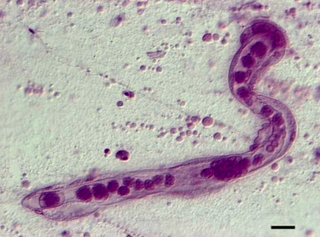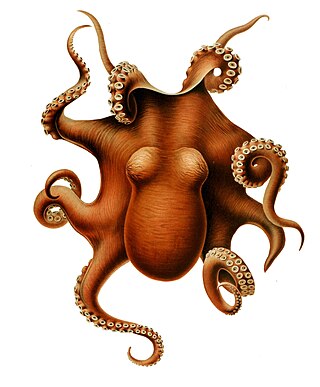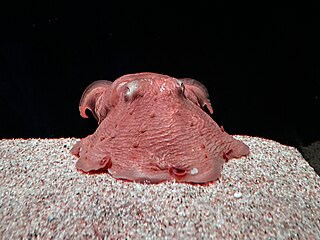
The Mesozoa are minuscule, worm-like parasites of marine invertebrates. Generally, these tiny, elusive creatures consist of a somatoderm of ciliated cells surrounding one or more reproductive cells.

The Octopodidae comprise the family containing the majority of known octopus species.

Dicyemida, also known as Rhombozoa, is a phylum of tiny parasites that live in the renal appendages of cephalopods.

Octopus is the largest genus of octopuses, comprising more than 100 species. These species are widespread throughout the world's oceans. Many species formerly placed in the genus Octopus are now assigned to other genera within the family. The octopus has 8 arms, averaging 20 cm long for an adult.

The giant Pacific octopus, also known as the North Pacific giant octopus, is a large marine cephalopod belonging to the genus Enteroctopus. Its spatial distribution includes the coastal North Pacific, along Mexico, The United States, Canada, Russia, Eastern China, Japan, and the Korean Peninsula. It can be found from the intertidal zone down to 2,000 m (6,600 ft), and is best adapted to cold, oxygen-rich water. It is arguably the largest octopus species.

Scaeurgus is a genus of octopuses in the family Octopodidae. The species of this genus are characterized by inhabiting the upper bathyal benthic zone from temperate and tropical latitudes in all major oceans.

Cancellaria cooperii, common name Cooper's nutmeg, is a species of medium-sized to large sea snail, a marine gastropod mollusk in the family Cancellariidae, the nutmeg snails.

Amphioctopus fangsiao, called webfoot octopus, is a species of octopus, a cephalopod belonging to the genus Amphioctopus. It is found in the Pacific Ocean, including off the coasts of New Zealand as well as in the Yellow Sea and surrounding Chinese shores. It is also commercially fished.
Aggregata is a genus of parasitic alveolates belonging to the phylum Apicomplexa.

Gyrodactylus is a genus of parasitic flatworms in the family Gyrodactylidae.

The Dicyemidae is a family of tiny parasites that live in the renal appendages of cephalopods. It contains the following genera and species:

Sepia prashadi, common name hooded cuttlefish, is a widely distributed species of cuttlefish. It has a thin, oval body and grows from 5 to 11 cm. The tips of the tentacles have a distinct club shape. S. prashadi is a migratory, demersal cuttlefish living in shallow waters at depths of approximately 40 to 50 metres. It is found in many locations including the east coast of Africa, around India, in the Red Sea, and Persian Gulf.

Bathypolypus arcticus, the North Atlantic octopus, deep sea octopus or spoonarm octopus is a small species of demersal octopus of the North Atlantic. It is usually found at depths of 200 to 600 m (660–1,970 ft) where the temperature is between 2 and 6 °C (36–43 °F).

Sepia elegans, the elegant cuttlefish, is a species of cuttlefish in the family Sepiidae from the eastern Atlantic Ocean and the Mediterranean Sea. It is an important species for fisheries in some parts of the Mediterranean where its population may have suffered from overfishing.

Muusoctopus is a cosmopolitan genus of deep-sea octopus from the family Enteroctopodidae. These are small to medium-sized octopuses which lack an ink sac. Recent work has suggested that these octopuses originated in the North Atlantic and subsequently moved into the North Pacific while the species in the Southern Hemisphere are descended from multiple invasions from northern oceans.
Diplectanum is a genus of monopisthocotylean monogeneans in the family Diplectanidae. The genus, created by Karl Moriz Diesing, gave its name to the family Diplectanidae. All its species are parasites of the gill lamellae of teleosts. The type-species of the genus is Diplectanum aequans(Wagener, 1857).

Sepioloidea lineolata or more commonly known as the striped pyjama squid or the striped dumpling squid is a type of bottletail squid, that inhabits the Indo-Pacific Oceans of Australia. Although it is almost a cuttlefish, it does not have a cuttlebone; it is otherwise exactly the same as cuttlefish. Therefore it is a sepioid, not a real cuttlefish. However, it is usually referred to as a cuttlefish for public simplification. It is not a squid either. The striped pyjama squid lives on the seafloor and is both venomous and poisonous. When fully mature, a striped pyjama squid will only be about 7 to 8 centimetres in length. Baby striped pyjama squids can be smaller than 10 millimetres (0.39 in).

Opisthoteuthis depressa, also known as the Japanese flapjack octopus, is an octopus found in waters near Japan.

Dicyema is a genus of worms belonging to the family Dicyemidae.
Frederick George "Eric" Hochberg (1941–2023) was a marine biologist specializing in the study of cephalopods and their parasites.















